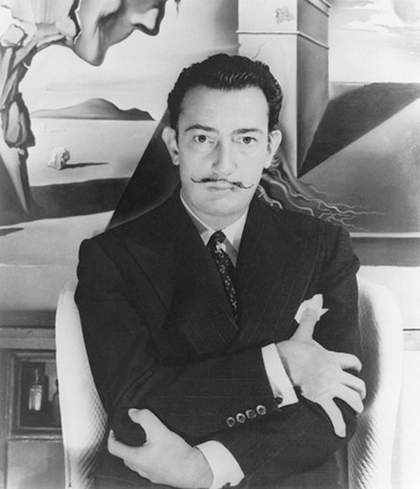Walt Disney first met Salvador Dalí at a dinner party at the home of Hollywood movie mogul Jack Warner in 1945. In fact, well before he came to America, Dalí had said that he wanted to meet Walt and Alfred Hitchcock, because he saw both of them as Surrealists. One source says that he wrote a letter back in 1937 to André Breton, the founder of the Surrealists, to say that he was in contact with the “three great American Surrealists – the Marx Brothers, Hitchcock and Walt Disney”, but I don’t know how true this is. At any rate, they obviously had something in common that went beyond just meeting at a dinner party. They admired each other’s work and the meeting sparked the idea of collaboration.
Walt was in touch with a lot of contemporary artists. He was interested in art as a broader subject, beyond the realms of animation. Certainly, if you look at some of the abstract animation pieces that were made leading up to Fantasia, and after it too, there were many artistic styles at work in there. I think he saw himself as an artist to a certain extent, but also as a little bit of a Medici, a patron of artists.
The Destino project was intended as a short film for a future feature. It was based on a Mexican ballad written by a fellow named Armando Dominguez. Walt loved to describe the thing as just a simple little love story, which is what it is, though Dalí – never one to keep it simple – would have taken about ten pages to explain it to you. Actually, there is a lot of written material about it. Walt brought in John Hench, who had a classical art background, to work with the artist on the story. Dalí produced about fifteen paintings and about 135 sketches. They worked closely together to the point where they couldn’t tell each other’s drawings apart. A lot of the pieces that survive from that time are mostly pen-and-ink story sketches on little five by seven slips of paper. John was the only one in the world, until he died, who could sit down with us and say: “That’s mine, that’s his.”
After eight months the project stopped because of money problems, but Hench took two painted cells of Dalí’s work and simulated an animated movie on a camera stand. This eighteen-second test was rediscovered in the studio’s film library some years later and was one of the things which led to the project being revived. It was quite a complicated production to work on, although the animation you see is relatively simple: objects transform from one thing into another. Both Dalí and Disney were fascinated with the idea of transformation. Certainly, it is a radical aspect of Disney and a common theme that runs through a lot of the films. Think of The Skeleton Dance from Silly Symphonies (1929) and, later, sections in Fantasia (1940). It is also a prominent feature of the Pink Elephants on Parade in Dumbo (1941), which I know Dalí had seen.
We spent a long time trying to figure out what we were doing. There was no original screenplay for the film, so the team had to pin up the drawings on a big board to get a sense of the story. Although using today’s technology, we wanted to stay within the terms of trying to decipher their intent and the meaning of the original project. So there was a little bit of museum work mixed in with filming. The modern techniques which we subsequently used – such as revolving cameras around objects - made sense, and are actually very Dalí-esque in themselves. I know that he and Walt would have gone nuts to be able to do that kind of filming.
I believe they influenced one another. Disney films can be seen as being incredibly surreal, and I imagine that is why Dalí was attracted to them. But also I think they worked well together because, above all, they were both incredible optimists. Dalí’s paintings can make you feel optimistic, and so do the Disney films.



